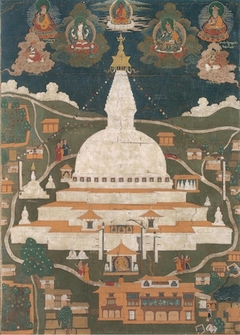Pilgrimage Series
Practices › Pilgrimage
English (41) | Deutsch (1) | Français (1) | Italiano (1) | 中文 (1) | བོད་ཡིག (41)

The Stūpa of Jarung Kashor
Courtesy of Himalayan Art Resources
Further information:
Lotsawa House presents the following texts related to pilgrimage (gnas skor) and major sacred places (gnas):
General
Sacred Places
- Melodious Tambura of Delight: A Guide to Māratika Cave, Supreme Site of Immortality by Chatral Rinpoche
- A Brief Petitionary Offering to the Mātṛkā Pukkasī, Local Protectress of the Jarung Kashor Stūpa by Dudjom Rinpoche
- A Prayer to the Great Sacred Site of Pema Shelpuk, Lotus Crystal Cave by Jamyang Khyentse Chökyi Lodrö
A two-verse prayer to the sacred site of Pema Shelpuk (pad+ma shel phug) composed in January 1925.
- A Song of Perfect Joy: In Praise of the Sacred Sites of Rājgṛha, Vulture Peak and Nālandā by Jamyang Khyentse Chökyi Lodrö
- Gathering Auspiciousness: A Prayer of Aspiration Made in the Presence of the Sacred Mahābodhi Temple and its Imagery, Magadha, Land of the Āryas by Jamyang Khyentse Chökyi Lodrö
- Offering Clouds to Delight the Victorious Ones, Combining A Praise of Redreng with a Prayer of Aspiration by Jamyang Khyentse Chökyi Lodrö
- Prayer of Aspiration to the Stūpa Commemorating the Bodily Sacrifice to the Tigress by Jamyang Khyentse Chökyi Lodrö
- The White Lotus Garland of Immortality: In Praise of the Supreme Vajra Place, Tso Pema (Lotus Lake) by Jamyang Khyentse Chökyi Lodrö
Songs
- Auspicious Dance of Longevity: A Song for Touring the Sacred Sites of Nepal by Jamyang Khyentse Chökyi Lodrö
A spontaneous song of joy, composed while on pilgrimage to Nepal in late 1956.